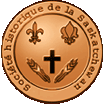The Festival's beginnings
Before the 1960s, the French-speaking population of Saskatchewan closely identified itself with French Canada and its values. The strengthening of Quebec nationalism in the 1960s led to the rise among Saskatchewan Francophones of a sense of belonging to their land and to the development of their own historical and cultural identity. Their French culture was permeated by the influence of several Francophone groups from America and Europe. They had gone through bitter struggles to keep their language. These historical experiences were among the factors which distinguished them from other French-Canadians.
This new awareness occurred at a time when the assimilation rate for Francophones was reaching 50%. It was at this time that the term Fransaskois appeared. In 1979 a new symbol was acquired, the Fransaskois flag. In her poem, La Fransasque, published in 1981, Éveline Hamon tried to express this spatial identity (audio). This cultural landscape encouraged events such as On s'garoche à Batoche and then the Fête fransaskoise (Fransaskois Festival).
(Source : ROUSSEL-BEAULIEU Frédéric, « De Franco-Canadien à Fransaskois : l'émergence d'une nouvelle identité francophone », Revue historique, décembre 2005)
Archives
The newspaper L'Eau vive publishes a survey on the name that Saskatchewan Francophones want to apply to themselves.
«Désormais 'Fransaskois'», 2 novembre 1972 (Fransaskois from now on)
The AJF organizes a design competition for a Fransaskois flag.
«Tous les critères du concours fixés», 15 novembre 1978(All the criteria for the competition have been set)
A Fransaskois flag is suggested by John Diefenbaker
Drapeau par John Diefenbaker
The poem La Fransaske by Éveline Hamon, published for the first time in the Revue littéraire de la Saskatchewan in 1981
(Source : ROUSSEL-BEAULIEU Frédéric, « De Franco-Canadien à Fransaskois : l'émergence d'une nouvelle identité francophone », Revue historique, décembre 2005)
Archives
The newspaper L'Eau vive publishes a survey on the name that Saskatchewan Francophones want to apply to themselves.
«Désormais 'Fransaskois'», 2 novembre 1972 (Fransaskois from now on)
The AJF organizes a design competition for a Fransaskois flag.
«Tous les critères du concours fixés», 15 novembre 1978(All the criteria for the competition have been set)
A Fransaskois flag is suggested by John Diefenbaker
Drapeau par John Diefenbaker
The poem La Fransaske by Éveline Hamon, published for the first time in the Revue littéraire de la Saskatchewan in 1981

